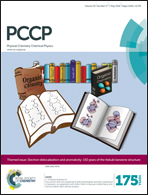Spectral dependence of direct and trap-mediated recombination processes in lead halide perovskites using time resolved microwave conductivity†
Abstract
Elucidating the decay mechanisms of photoexcited charge carriers is key to improving the efficiency of solar cells based on organo-lead halide perovskites. Here we investigate the spectral dependence (via above-, inter- and sub-bandgap optical excitations) of direct and trap-mediated decay processes in CH3NH3PbI3 using time resolved microwave conductivity (TRMC). We find that the total end-of-pulse mobility is excitation wavelength dependent – the mobility is maximized (172 cm2 V−1 s−1) when charge carriers are excited by near bandgap light (780 nm) in the low charge carrier density regime (109 photons per cm2), and is lower for above- and sub-bandgap excitations. Direct recombination is found to occur on the 100–400 ns timescale across excitation wavelengths near and above the bandgap, whereas indirect recombination processes displayed distinct behaviour following above- and sub-bandgap excitations, suggesting the influence of different trap distributions on recombination dynamics.



 Please wait while we load your content...
Please wait while we load your content...